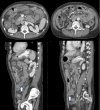Lupus Enteritis: An Uncommon Presentation of Lupus Flare
- PMID: 34671520
- PMCID: PMC8520498
- DOI: 10.7759/cureus.18030
Lupus Enteritis: An Uncommon Presentation of Lupus Flare
Abstract
Gastrointestinal (GI) symptoms are common in systemic lupus erythematosus (SLE) but are usually attributable to medication side effects, infections, or other underlying conditions. In rare cases, they are caused by the autoimmune process itself. In this report, we present two cases of lupus enteritis as the sole manifestation of lupus flare. We also provide a comprehensive review of available literature on this topic with a specific focus on clinical symptoms, complications, laboratory findings, histology, imaging findings, and therapies. Lupus enteritis is an uncommon manifestation of SLE. CT scan of the abdomen is the diagnostic modality of choice. The three major CT findings are target sign, comb sign, and increased mesenteric fat attenuation. Ascites is also commonly present. Corticosteroids and second-line immunosuppressants have been successfully employed in the treatment of lupus enteritis. Our cases highlight this unusual manifestation as the only symptom of active SLE. A high index of suspicion should be maintained when evaluating SLE patients presenting with GI symptoms to prevent diagnosis and treatment delays that could lead to serious complications such as bowel necrosis, perforation, and even death.
Keywords: gastrointestinal symptoms; lupus enteritis; lupus flare; mesenteric vasculitis; systemic lupus erythematosus.
Copyright © 2021, Potera et al.
Conflict of interest statement
The authors have declared that no competing interests exist.
Figures


Similar articles
-
Lupus Enteritis in the Absence of a Lupus Flare. A Case Report and Review of Literature.J Community Hosp Intern Med Perspect. 2022 Nov 7;12(6):73-78. doi: 10.55729/2000-9666.1129. eCollection 2022. J Community Hosp Intern Med Perspect. 2022. PMID: 36816163 Free PMC article.
-
A Flare-up of Systemic Lupus Erythematosus with Unusual Enteric Predominance.Cureus. 2020 Feb 21;12(2):e7068. doi: 10.7759/cureus.7068. Cureus. 2020. PMID: 32226670 Free PMC article.
-
Lupus enteritis as the only active manifestation of systemic lupus erythematosus: A case report.World J Clin Cases. 2019 Jun 6;7(11):1315-1322. doi: 10.12998/wjcc.v7.i11.1315. World J Clin Cases. 2019. PMID: 31236395 Free PMC article.
-
Lupus enteritis as the sole presenting feature of systemic lupus erythematosus: case report and review of the literature.Paediatr Int Child Health. 2019 Nov;39(4):294-298. doi: 10.1080/20469047.2018.1504430. Epub 2018 Sep 7. Paediatr Int Child Health. 2019. PMID: 30191770
-
Gastrointestinal and Hepatic Disease in Systemic Lupus Erythematosus.Rheum Dis Clin North Am. 2018 Feb;44(1):165-175. doi: 10.1016/j.rdc.2017.09.011. Rheum Dis Clin North Am. 2018. PMID: 29149925 Free PMC article. Review.
Cited by
-
A Rare Manifestation of Abdominal Pain in Systemic Lupus Erythematosus: A Case Report on Lupus Enterocolitis.Cureus. 2025 Apr 21;17(4):e82750. doi: 10.7759/cureus.82750. eCollection 2025 Apr. Cureus. 2025. PMID: 40406783 Free PMC article.
-
Lupus Enteritis: Presentation as an Apparent Surgical Emergency - A Case Report.Mediterr J Rheumatol. 2025 May 23;36(2):335-338. doi: 10.31138/mjr.090324.ari. eCollection 2025 Jun. Mediterr J Rheumatol. 2025. PMID: 40757137 Free PMC article.
-
Recurrent Lupus Enteritis While on Chronic Immunosuppressant Therapy.Cureus. 2022 Oct 10;14(10):e30149. doi: 10.7759/cureus.30149. eCollection 2022 Oct. Cureus. 2022. PMID: 36397920 Free PMC article.
-
A Rare Case of Lupus Nephritis with Predominant Gastrointestinal Manifestation: A Case Study.J Pharm Bioallied Sci. 2024 Dec;16(Suppl 5):S4890-S4892. doi: 10.4103/jpbs.jpbs_1204_24. Epub 2025 Jan 30. J Pharm Bioallied Sci. 2024. PMID: 40061682 Free PMC article.
-
Rare case of lupus enteritis presenting as colorectum involvement: A case report and review of literature.World J Clin Cases. 2023 Dec 6;11(34):8176-8183. doi: 10.12998/wjcc.v11.i34.8176. World J Clin Cases. 2023. PMID: 38130788 Free PMC article.
References
-
- The gastrointestinal manifestations of systemic lupus erythematosus: a review of the literature. Hoffman BI, Katz WA. Semin Arthritis Rheum. 1980;9:237–247. - PubMed
-
- Lupus enteritis: clinical characteristics and predictive factors for recurrence. Koo BS, Hong S, Kim YJ, Kim YG, Lee CK, Yoo B. Lupus. 2015;24:628–632. - PubMed
-
- Lupus enteritis: clinical characteristics, risk factor for relapse and association with anti-endothelial cell antibody. Kwok SK, Seo SH, Ju JH, et al. Lupus. 2007;16:803–809. - PubMed
-
- Autoimmune gastrointestinal complications in patients with systemic lupus erythematosus: case series and literature review. Alves SC, Fasano S, Isenberg DA. Lupus. 2016;25:1509–1519. - PubMed
Publication types
LinkOut - more resources
Full Text Sources
